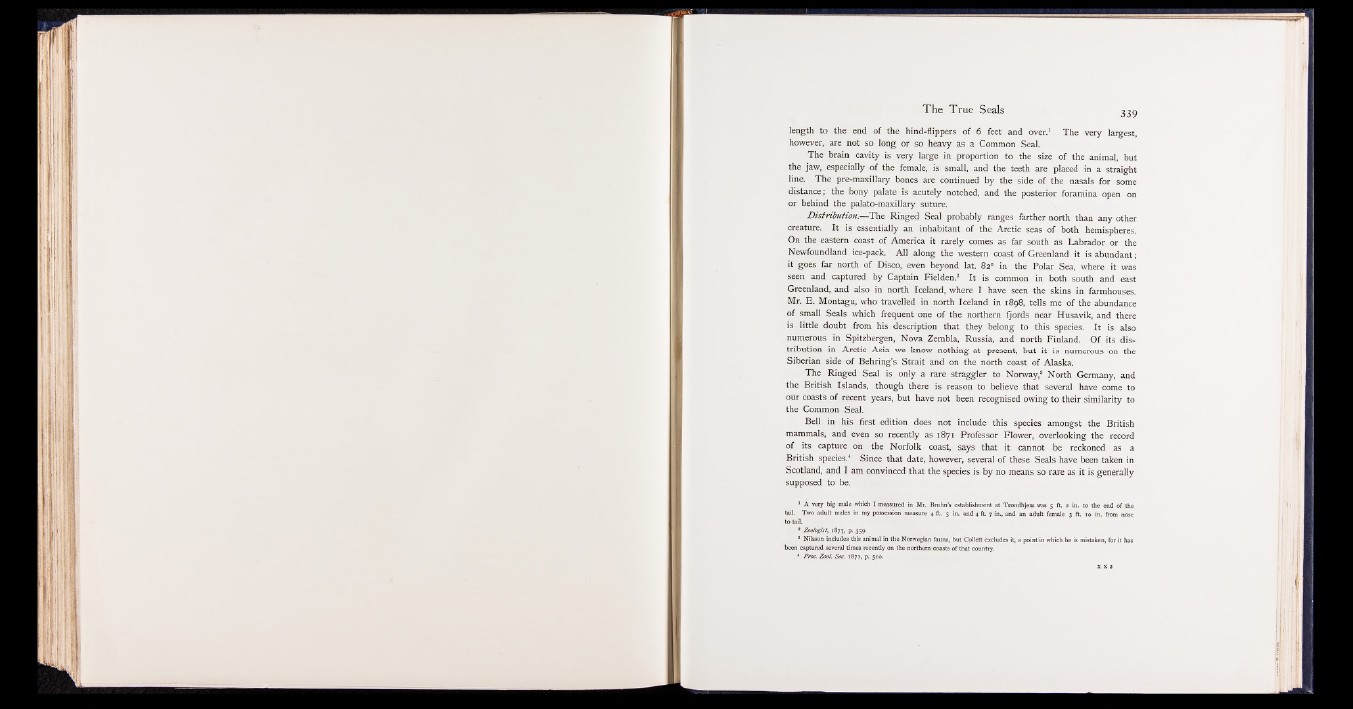
The True Seals 3 3 9
length to the end of the hind-flippers of 6 feet and over.1 The very largest,
however, are not so long or so heavy as a Common Seal.
The brain cavity is very large in proportion to the size of the animal, but
the jaw, especially of the female, is small, and the teeth are placed in a straight
line. The pre-maxillary bones are continued by the side of the nasals for some
distance; the bony palate is acutely notched, and the posterior foramina open on
or behind the palato-maxillary suture.
Distribution.— The Ringed Seal probably ranges farther north than any other
creature. It is essentially an inhabitant of the Arctic seas of both hemispheres.
On the eastern coast of America it rarely comes as far south as Labrador or the
Newfoundland ice-pack. All along the western coast of Greenland it is abundant;
it goes far north of Disco, even beyond lat. 82° in the Polar Sea, where it was
seen and captured by Captain Fielden.1 2 3 It is common in both south and east
Greenland, and also in north Iceland, where I have seen the skins in farmhouses.
Mr. E. Montagu, who travelled in north Iceland in 1898, tells me of the abundance
of small Seals which frequent one of the northern fjords near Husavik, and there
is little doubt from his description that they belong to this species. It is also
numerous in Spitzbergen, Nova Zembla, Russia, and north Finland. Of its distribution
in Arctic Asia we know nothing at present, but it is numerous on the
Siberian side of Behring’s Strait and on the north coast of Alaska.
The Ringed Seal is only a rare straggler to Norway,8 North Germany, and
the British Islands, though there is reason to believe that several have come to
our coasts of recent years, but have not been recognised owing to their similarity to
the Common Seal.
Bell in his first edition does not include this species amongst the British
mammals, and even so recently as 1871 Professor Flower, overlooking the record
of its capture on the Norfolk coast, says that it cannot be reckoned as a
British species.4 Since that date, however, several of these Seals have been taken in
Scotland, and I am convinced that the species is by no means so rare as it is generally
supposed to be.
1 A very big male which I measured in Mr. Bruhn’s establishment at Trondhjem was 5 ft. 2 in. to the end of the
tail. Two adult males in my possession measure 4 ft. 5 in. and 4 ft. 7 in., and an adult female 3 ft. ro in. from nose
to tail.
* Zoologist, 1877, p. 359.
3 Nilsson includes this animal in the Norwegian fauna, but Collett excludes it, a point in which he is mismlwn, for it has
been captured several times recently on the northern coasts of that country.
4 Proc. Zool. Soc. 1871, p. 510.